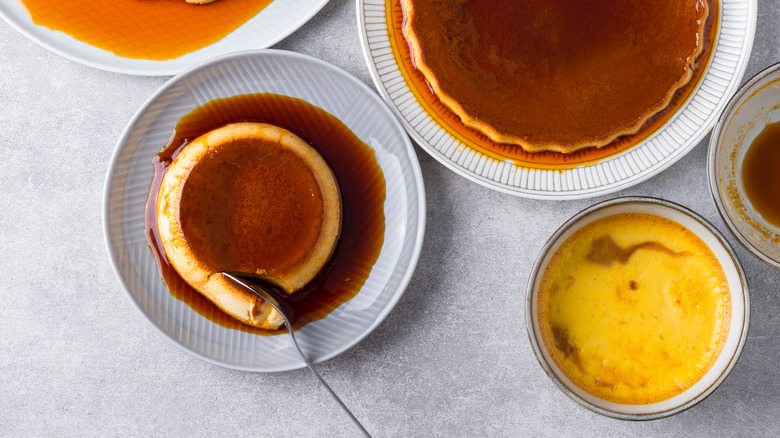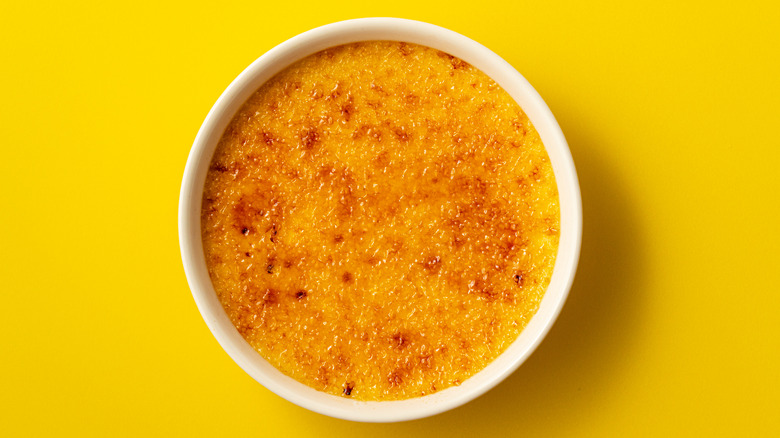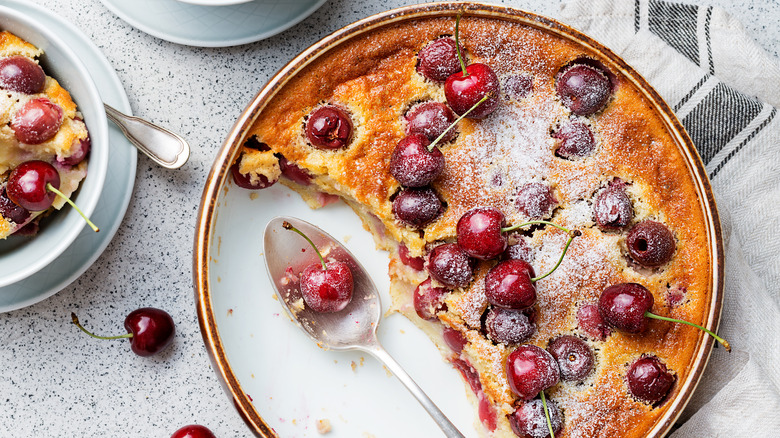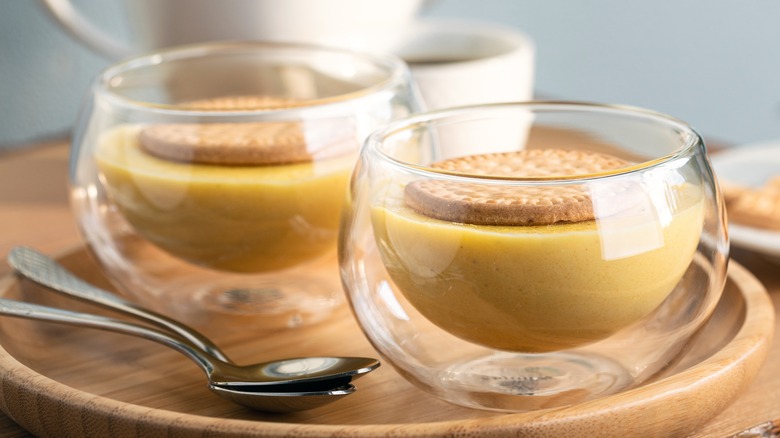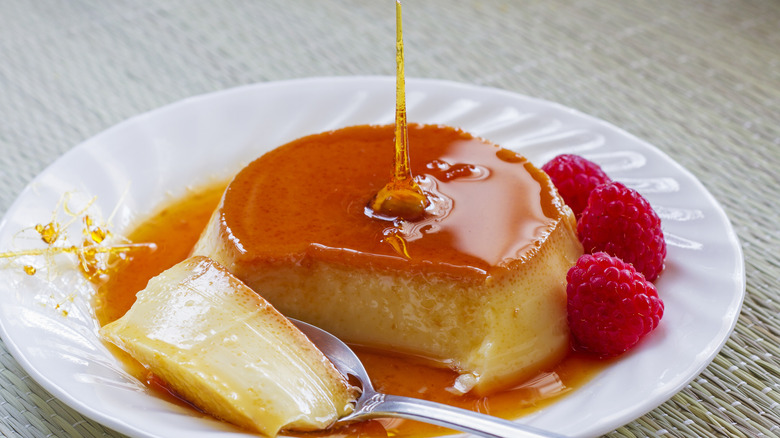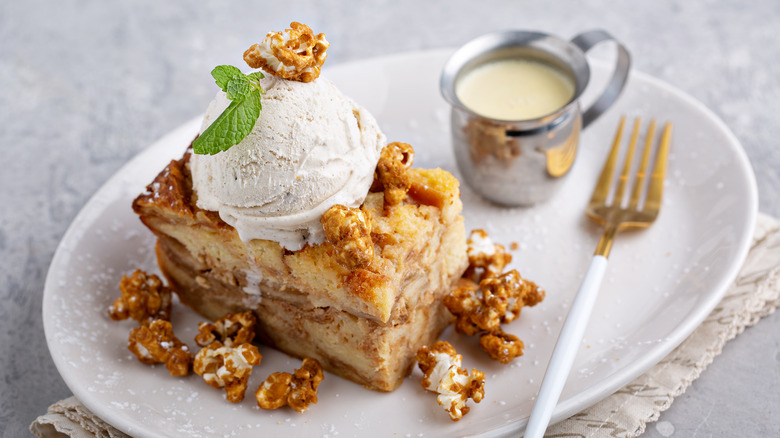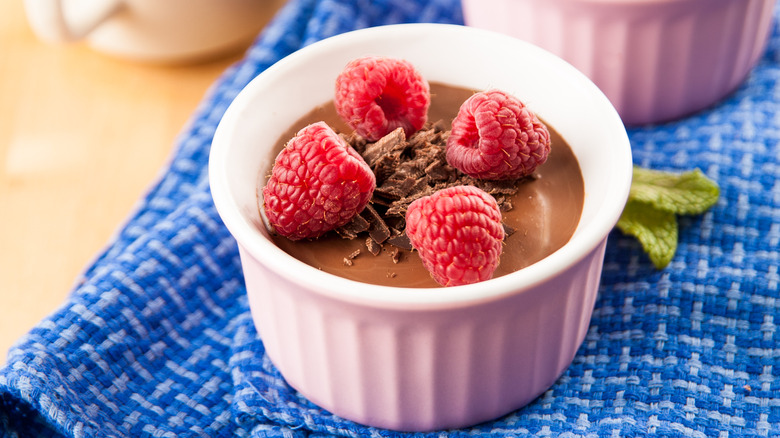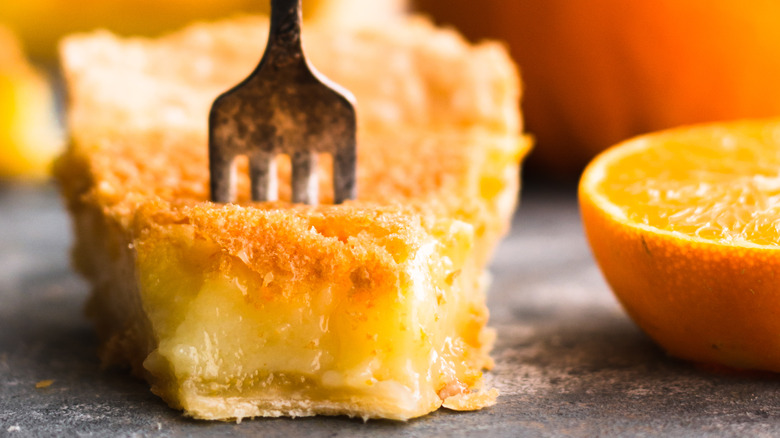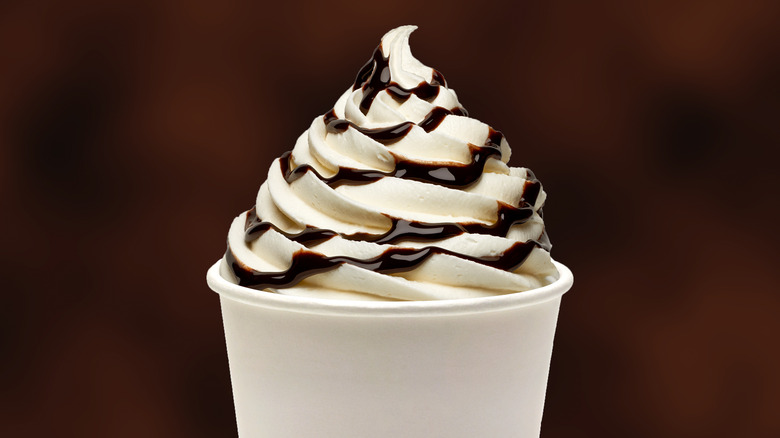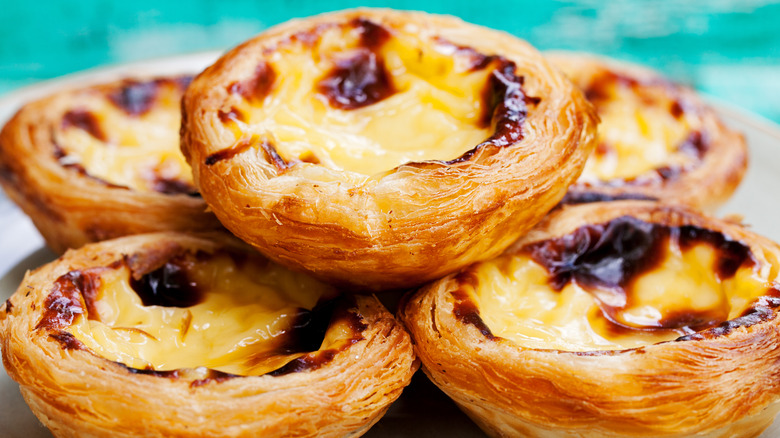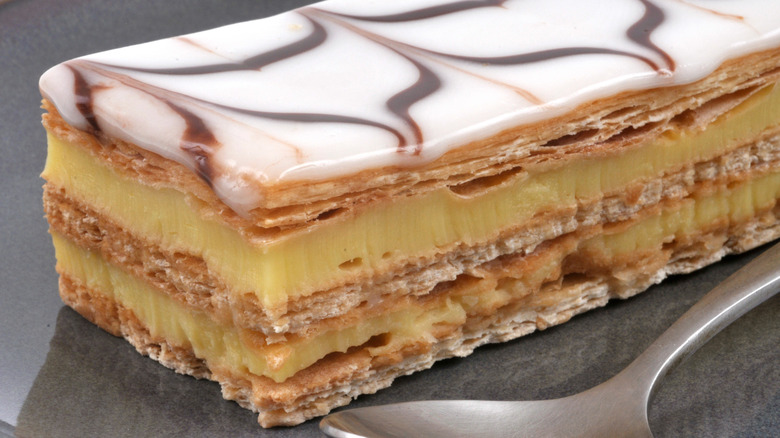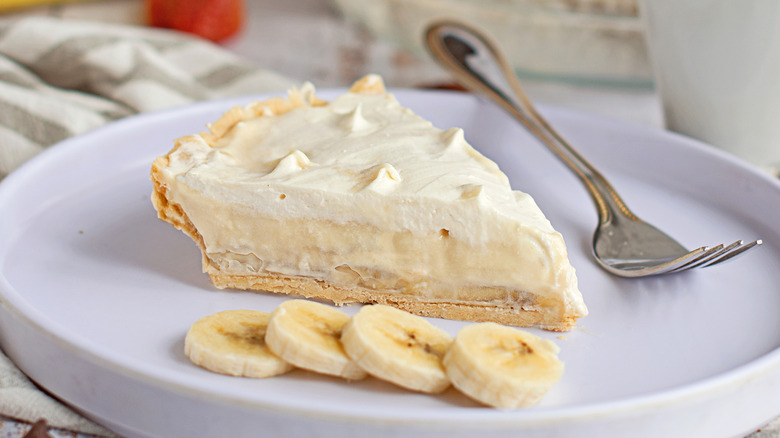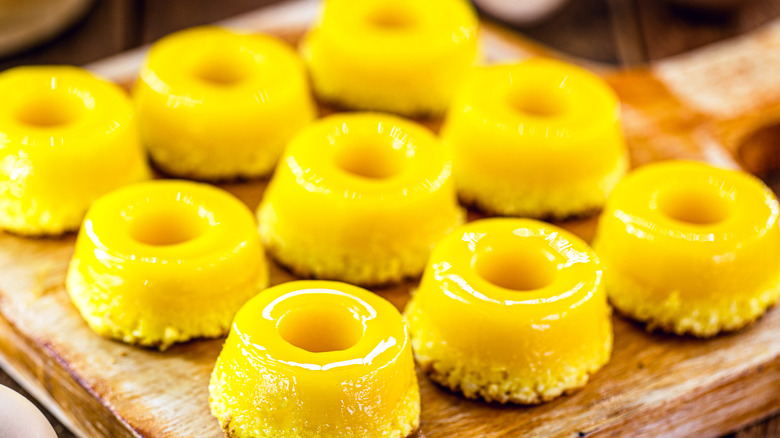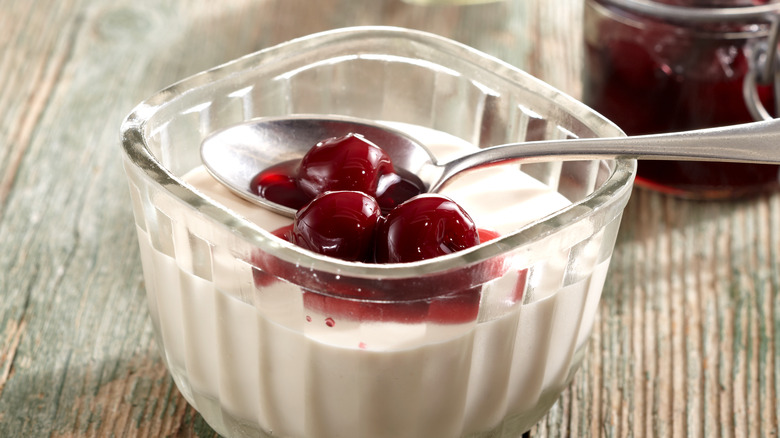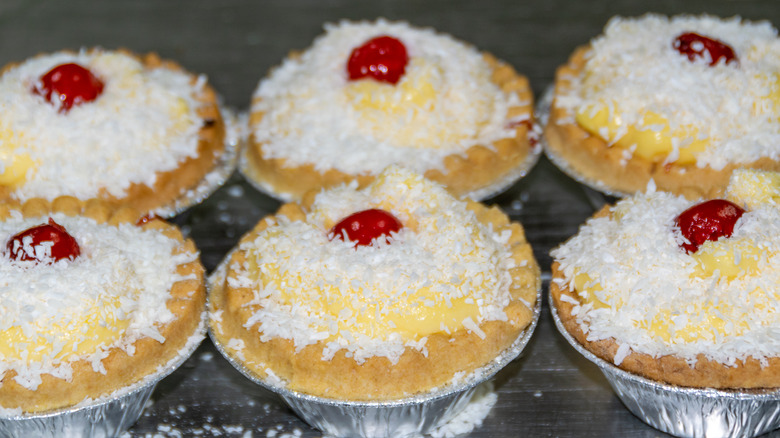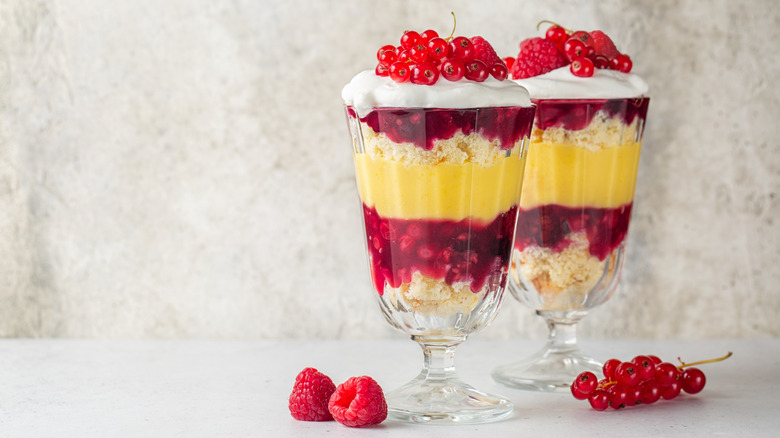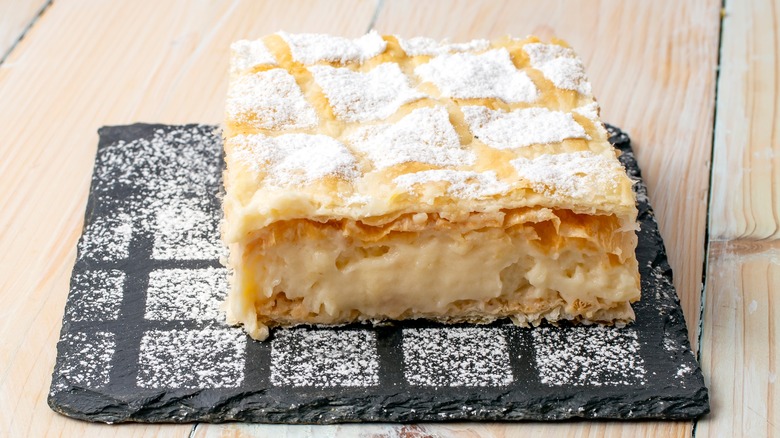17 Types Of Custard Desserts, Explained
If you're a fan of silky and rich-tasting foods, custards are likely high on your list (and if you haven't tried them, you should give them a chance). Although there are numerous styles of custard desserts out there, they all have one common denominator: eggs. In fact, the major difference between custard and pudding is that eggs act as the primary thickening agent for custard instead of flour or different starch powders.
You can serve some custard desserts by themselves as a simple yet decadent goody that you can eat by the spoonful. On the other hand, some custards are used as fillings for things like doughnuts and pies. Whichever the case, every type of custard on this list has its own history. Once you learn the background and characteristics of these different sweet treats, it will be easier to appreciate each kind. They may have their similarities, but each custard has its own twist.
Crème brûlée
Crème brûlée is one of the most renowned custards out there. A classic crème brûlée typically consists of egg yolks and cream sweetened with sugar and vanilla. It distinguishes itself from others with its caramelized sugar atop the baked custard. Crème brûlée is a French dessert, right? Not so fast, despite its name, crème brûlée's true origin remains a mystery.
A few different countries — specifically England, Spain, and France — all have some sort of tie to the dessert that goes back in history, even as far as the Middle Ages. This means that any of those places can be the motherland of this creamy delight because there isn't a clear answer to which one actually is. In each location, the velvety food went by a different name (burnt cream in England and crema Catalonia in Spain) but had virtually the same ingredient makeup. However, it makes sense why people would assume it was the French who created it because of the famous French name it still carries today.
Clafoutis
Clafoutis is a baked treat in which the egg base has a simple flavor profile, which allows the other components (fresh fruit) flavors to be more prominent. The usual ingredients for this dish are eggs, sugar, flour, milk, salt, vanilla, and seasonal fruit. The most traditional version of clafoutis is cherry clafoutis. However, people can make it with all sorts of fruits, and it even sometimes goes by the name of flognarde in that instance (even though the type of fruit used is the only thing that sets it apart).
Clafoutis is light and airy; it is commonly made in a large pie dish or skillet and sliced like a pie. France can take the credit for this custard, but home cooks don't need to travel abroad to enjoy it. In fact, this dish is one of the best French recipes to make for brunch since it is easy to bring to life; foodies can enjoy it as a dessert or breakfast treat.
Zabaglione
Zabaglione is an Italian alcohol-infused custard dessert. Do we have your attention yet? Although Italy is known for other foods like pasta or gelato, zabaglione is the boozy Italian custard you should know about. The dish is pleasantly smooth, and Italians usually make it with local wines, especially Marsala. Nevertheless, variations have come about — people can make it with a different type of alcohol depending on taste preference and what is accessible to them.
Aside from the alcohol — which takes up most of the space flavor-wise — the dish also has egg yolks, sugar, and salt. A chef named Bartolomeo Stefani wrote the first cookbook to contain the recipe way back in the 1660s. However, it isn't likely that Stefani was the actual inventor of the sweet treat. Even though this dish isn't the most well-known in the United States, the locals in Italy create all sorts of different zabaglione-flavored foods, so it is undoubtedly a delicacy in its place of origin.
Flan
With a three-ingredient base, flan is the perfect example of less is more. Eggs, milk, and sugar serve as the foundation for the dessert, while caramel sauce adorns the top (at least it does in the Spanish rendition). There has been much discourse on how to pronounce the dessert correctly. Some argue whether or not it should rhyme with "fawn" or "fan" when saying it. In reality, both ways are correct, and people from different places say it differently.
When flan comes to mind, you likely think of the renowned Spanish version, but the untold truth of flan is that there are many variations of it. The creamy yet gelatinous confection is enjoyed worldwide, with Asia, Europe, and Latin America being some of the places that partake in it. Families in Latin America, Spain, and the Philippines especially appreciate flan on Christmas Eve as a traditional holiday food. Regardless, you don't need to view it as just a festivity food; it's just as delicious and decadent on a random weekday.
Bread pudding
Bread pudding is a dish that has a custard base but also involves another critical ingredient: stale bread. The bread is chopped into cubes and soaked in the egg mixture before baking. Bakers have been known to use almost any bread, from dinner rolls to bagels or even sourdough. This dessert originated in England as a way to reduce food waste, because why throw bread out if you don't need to?
Some might wonder if strata and bread pudding have differences, and the truth is that they do. Although they are both custards with bread, bread pudding is more of a dessert because it involves vanilla and sugar. Strata, meanwhile, is savory, and while it is tasty, it doesn't belong in the same sweet category as bread pudding. Bread pudding has come a long way since its creation in the 12th century, as the recipe has evolved to be much sweeter than it originally was. But one thing hasn't changed — it is a perfect way to utilize old bread.
Pot de crème
Traditional chocolate pot de crème is a French dessert that uses the water bath baking method. You make the classic version by baking it. There are also no-bake versions of it today, in which you make the custard and then place it in the fridge to set it up without any baking involved (which, by the way, is how Ree Drummond executes her pots de crème, which is one of her favorite treats to make).
The high number of eggs paired with the chocolate makes the dish beyond rich. Aside from the original style, bakers have gotten creative and made other flavors of the silky treat, like maple or vanilla-flavored pots de crème. The sweet treat's name translates to "pot of cream," which makes sense because people initially served it in certain tiny pots; not a cooking pot, but a serving one with a matching cover. Nowadays, it is usual for bakers to make it in glass ramekins.
Chess pie
Chess pie is the Southern staple that will satisfy your sweet tooth. Its simple yet sugary flavor makes it enchanting. The custard base has butter, eggs, and sugar. It also has some sort of thickening agent (traditionally, cornmeal) and an acidic ingredient for flavor. People often credit the American South for this flaky and buttery delight, but technically it is an English dessert that grew in popularity in the South.
Although this treasure of a treat might be a favorite to Southerners, it hasn't necessarily made a name for itself in every region of the United States. And while the custard's place of creation is definite, the origins of chess pie's name are ambiguous. Some believe the name stemmed from "cheese" pie. On the other hand, others argue that the phrase "just pie" got lost in translation, and by some means, it turned into "chess pie." Some questions about the pie remain, but it is clear that people enjoy it, and that's what counts, right?
Frozen custard
Although you make most of the custards on this list by baking them, this one is the polar opposite. People often think that frozen custard and ice cream are identical and that you can use their names interchangeably, but that's not true. First, it is essential to know what makes frozen custard different from ice cream: the addition of egg yolks. Milk, sugar, yolks, cream, and other flavorings make up the frozen custard.
Like other custards, eggs make the dessert more stable and have a richer flavor. It's just more than a century old and was first sold in Coney Island, New York. This American creation began as a boardwalk treat for hot summer days, but now, you can buy it in the average grocery store. It has certainly come a long way, and out of all the types of frozen desserts out there, it offers a custardy goodness that the others don't.
Portuguese egg tart
Portuguese egg tarts, or pastel de nata, are baked tarts that the Portuguese serve in individual portions. Their filling is made from sugar, eggs, milk, flour, and cinnamon, while it has a puff pastry crust that is delightfully flaky. Similar to bread pudding, people invented this confection to utilize food scraps. Specifically, you can thank Catholic monks for the genius idea to turn extra egg yolks into this charming custard.
The bakery that first sold pastel de nata was just outside of Lisbon, and this is still the same area where you can find the best egg tarts in Portugal today. The tiny tarts are appreciated by tourists, of course, but even locals seem never to get tired of them. Some bakeries in the area (and throughout the country) specialize in and only sell pastel de nata, just as you would find cupcake shops in the U.S. The eggy bake is so famous that bakeries form an assembly line-style process to get the job done, ensuring that they make the Portuguese egg tarts in the quickest and most efficient way possible.
Galaktoboureko
Galaktoboureko is a Greek custard that isn't necessarily known worldwide, but people in its place of origin certainly appreciate it. If you were to break down what its name means, you could trace it back to Greek and Turkish languages. The first part of the word (gala) means milk in Greek, which makes a ton of sense because milk is one of the custard's core ingredients. Meanwhile, the last part of the word (bourek) means pastry in Turkish.
The particular kind of pastry that people use for Galaktoboureko is phyllo pastry, which is incredibly buttery and crisp at the same time. Galaktoboureko has two layers of phyllo, while the eggy filling resides in between. It is undeniably one of the Greek dishes you need to try at least once. Plus, it can be enjoyed as a dessert or as a morning pastry, so you can even pair it with a hot cup of joe if you wish.
Mille-feuille
Mille-feuille is yet another custardy confection that the French introduced. It looks awfully similar to a napoleon, and people often mistake them for each other. However, a mille-feuille recipe will include a vanilla-based filling, while napoleon's filling is almond-based. Its name translates to a "thousand sheets" or "thousand leaves," likely because you make puff pastry with layers upon layers of flour and butter.
The history of mille-feuille is alluring because the exact inventor of the dessert is unknown. Nevertheless, you can trace the oldest written formula for the flaky gem back to the 1600s. François Pierre de la Varenne was the author of the notorious cookbook ("Le Cuisinier François") where you can find it. Another peculiar thing about the dessert is that it can double as a savory dish if you tweak the filling and add other components like veggies. Regardless, the sweet and indulgent version is the traditional type and will always reign supreme.
Banana cream pie
Here is a custard pie that you likely recognize and might even hold near and dear to your heart. The banana cream pie is a captivating variation of a classic custard pie. The famous dessert has a baked crust, custard filling, sliced bananas, and whipped cream. While the banana cream pie has 19th-century origins, it gained momentum in America in the middle of the 20th century. It was a treat of choice for American soldiers in the 1950s. Yet, it wasn't always the custardy treat you're familiar with.
The original version is just as delightful, just in a different way: Bakers would place sugared banana slices in a pie crust and bake it, which would tenderize the bananas and make them creamier. The milky custard didn't come into play until later on. Even so, one parallel between the old and new formulas is the fluffy whipped cream topping.
Quindim
Quindim is one of the iconic Brazilian foods you need to try before you die, especially if you enjoy tropical treats. This Brazilian custard has many egg yolks, making its appearance a vibrant yellow-orange and much more vivid than the average custard. The cream and milk elements in other eggy desserts tend to dilute the yolk color. But since you only make this one with sugar, yolks, and coconut, there isn't room for that. People usually create it in individual portions and serve it upturned like flan.
Desserts like this made their way to Brazil because Portuguese colonizers brought over different recipes and techniques, specifically foods high in egg yolks. Quindim is exceptionally comparable to a particular Portuguese recipe (brisas do lis), but the coconut in quindim is what makes it distinct. Brazilian people use all locally sourced components for the dish, even the coconut, which makes it more authentic.
Bavarian cream
Bavarian cream is a custard that people traditionally serve as a molded dessert; you can garnish it with fresh fruits or sauces (via CHEFIN). What makes this custard so creamy and fluffy is whipped cream folded into the eggy base. The recipe requires bakers to cook it on the stovetop (rather than baking it) and then leave it to set up in a chilled environment. It is versatile because you can also use it to fill pâte à choux or have it act as a replacement for pastry cream in other filled pastries.
Bakers also take advantage of its flavor and texture by using it in cakes. The first known recorded formulas for Bavarian cream stem from the 19th century, so it's no stranger to the world of pastries. CHEFIN reports that although you can likely credit Marie-Antoine Carême for its creation, it is not definite. Bavarian cream goes by different names (creme bavaroise or bavarois) depending on the context, but it is all the same.
Manchester tart
The Manchester tart is a custard-filled tart with raspberry jam. It is commonly topped with powdered sugar, fresh fruit, and shredded coconut, as reported by Foods of England. To be specific, cherries or raspberries are the most popular fruits that play a part in complementing the custard filling and short-crust pastry. As you can probably guess, Manchester, England, is the birthplace of this charming treat.
People often associate it with (and mistake it for) Manchester pudding which also has an egg mixture base. So, someone likely took inspiration from Manchester pudding, which is how the tart came about, although the exact inventor is unknown. An interesting thing about the Manchester tart is that schools frequently served it to students during their lunch breaks, also referred to as school dinner in England. The tart is no longer a standard in schools, as that practice fizzled out sometime around the 1980s. But, instead, it is now appreciated in other circumstances and is considered a traditional pastry.
Trifle
If you appreciate detailed foods, then you'll absolutely want to learn what a trifle is and how you make it. Even though this confection isn't exclusively custard, it has a custard-based filling and certainly deserves to be on this list. Making trifles involves layering sponge cake (or sometimes lady fingers), custard, and fruit. Traditionally, people would soak the cake in alcohol before incorporating it into the dessert, although newer versions might skip that step. Adding whipped cream to the sweet treat is also an option, whereas the custard is a must.
Since the trifle is layered, it only makes sense that people assemble it in a transparent glass dish so that they can admire its gorgeous, intricate pattern. Foodies can make this treat with as many layers as they wish, but the classic version had no more than three or four. You can thank the English for this marvelous work of art that is fruity, custardy, and light.
Cremeschnitte
Cremeschnitte often gets confused with mille-feuille because they have similar components. However, cremeschnitte only has puff pastry at the top and bottom, which acts as more of a crust. Meanwhile, the custard occupies the middle. Bakers then adorn the pastry with powdered sugar or icing, on which they create a design. Central and eastern regions of Europe cherish this delicacy, as an unknown creator made it during the union of Austria and Hungary, according to Cake Gallery.
Additionally, people in Bled, Slovenia, recognize a specific version of cremeschnitte (called the Bled cream cake) as the famous dessert of their town (via National Geographic). Austria and Hungary border Slovenia; it is thus understandable how different variations of cremeschnitte have been popping up in areas surrounding its origin. It is safe to say that people from many European countries hold this pastry in high regard.
